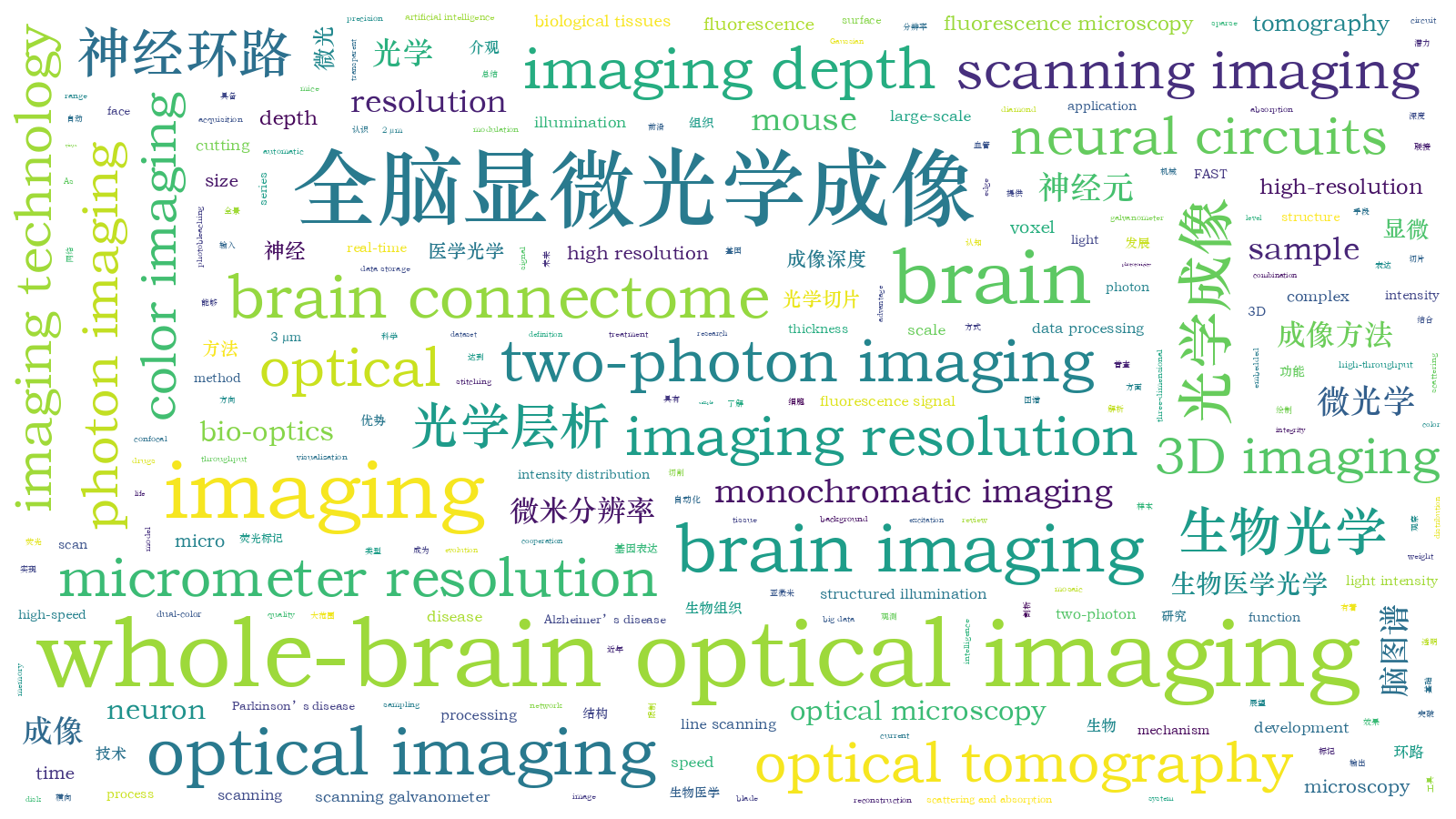全脑显微光学成像  下载: 1578次封面文章
下载: 1578次封面文章
The brain is one of the most complex systems, the culmination of evolution over billions of years of life. But until now we have not been able to accurately describe the mechanism of memory, thought and consciousness. Due to the lack of understanding of the structure and function of the brain, we have no effective drugs and treatments for neurological diseases such as schizophrenia, epilepsy, Alzheimer’s disease, and Parkinson’s disease. The structure of the brain is extremely complex and can be divided into different levels, such as brain lobes, neural circuits, neurons, synapses, and even molecules. The brain’s powerful function stems from its huge number of nerve cells and their complex interconnections.
The mapping of whole-brain mesoscopic neural connections in model animals such as mice requires technical tools that can achieve large-scale acquisition of high-resolution three-dimensional data in the centimeter scale. Optical imaging methods can achieve sub-micron resolution in lateral direction and can realize “optical sectioning” by various means, which have the natural advantage of observing neural circuits at the mesoscopic level. In this review, we summarize the various kinds of whole-brain optical imaging methods developed in recent years and look forward to future technological development.
Due to the scattering and absorption of biological tissues, the imaging depth of traditional optical methods is limited, and only tens of microns to hundreds of microns of the shallow layer of mouse brain can be imaged. To break through the limitation of imaging depth in biological tissues and achieve high voxel resolution and large-scale 3D imaging, optical microscopy must be combined with histological methods (Fig. 1).
Tissue clearing based whole-brain optical imaging methods are technologies that first clear biological tissues to improve optical imaging depth, and then use light-sheet fluorescence microscopy (LSFM) for rapid imaging (Fig. 2). For a whole mouse brain sample, rapid imaging of micrometer resolution can be completed in a few hours or less by LSFM. LSFM can achieve good optical sectioning with low photobleaching and phototoxicity. However, the imaging resolution of LSFM decreases significantly with the increase in the depth of the sample, and the resolution is lower when a large sample is fully imaged.
Mechanical sectioning based whole-brain optical imaging methods are a combination of optical sectioning and tissue cutting. After acquiring the images of the shallow part of sample each time, the sample surface is cut off with a knife. Through the continuous cycle of “imaging-cutting” process, the 3D fine structures of centimeter-size sample can be obtained. Representatives of this technology include serial two-photon tomography (STP), block-face serial microscopy tomography (FAST), and micro-optical sectioning tomography (MOST) series technologies.
STP combines high-speed two-photon imaging with vibrating sectioning, and can realize Z-interval sampling imaging of mouse brain (Fig. 3). With the use of resonant scanning galvanometer and higher excitation light intensity, the speed of STP imaging is further improved. By optimizing the mouse brain clearing method, the imaging depth can be improved to more than 200 μm. Finally, the high-resolution mouse brain data of 0.3 μm×0.3 μm×1 μm can be obtained within 8-10 days.
FAST uses spinning-disk confocal technology to image shallow tissues within a thickness of about 100 μm, and can complete monochromatic imaging of whole mouse brain within 2.4 h at a voxel size of 0.7 μm×0.7 μm×5 μm (Fig. 4). Sparse imaging and reconstruction tomography (SMART) uses low-resolution imaging results to determine whether there is fluorescence signal in the current region to narrow the next scan region, enabling rapid fine imaging of transparent sparse labeled mouse brain.
MOST uses a diamond knife to perform continuous sectioning of 1 μm thickness of resin-embedded mouse brain samples, and at the same time performs line scanning imaging of sample sections on the blade edge (Fig. 5). The mouse brain Golgi staining dataset with a voxel size of less than 1 μm3 has been acquired for the first time. Structured illumination fluorescence micro-optical sectioning tomography (SI-fMOST) adopts structured illumination method to achieve high-throughput imaging of the sample block-face by mosaic scan stitching (Fig. 5). Combined with real-time staining, dual-color imaging of mouse brain can be completed in 3 days with voxel size of 0.32 μm×0.32 μm×2 μm. High-definition fluorescence micro-optical sectioning tomography (HD-fMOST) uses the Gaussian intensity distribution of line illumination as a natural modulation, and can effectively remove background through simple subtraction (Fig. 5). The MOST series technologies combine embedding brain samples, micro-optical imaging and automatic precision cutting to form a unique technical system. The collected datasets are characterized by excellent integrity, high resolution, and good quality.
The whole-brain imaging technologies achieve unprecedented resolution, imaging speed and imaging range, making it possible to study the whole-brain circuit network. These technologies have gradually become a powerful tool in neuroscience and will continue to develop into more universal research tools, thus showing more application value.
To map neural circuits, it is necessary not only to develop imaging technology, but also to develop methods such as sample labeling and preparation, massive data storage, processing, and visualization. In recent years, the development of various virus tracing tools has promoted the labeling of neural circuits. But how to process and analyze massive whole-brain imaging data and extract knowledge from it is likely to become a bottleneck.
As the closest species to humans, non-human primates are of great value for the study of cognitive behavior, disease mechanism and treatment. However, the weight of macaque brain is about 200 times that of a mouse brain, which poses great challenges to sample labeling preparation, imaging technology and big data processing.
Through interdisciplinary cooperation, whole-brain optical imaging will further flourish, demonstrate its unique application value in neuroscience, promote our knowledge and understanding of the brain, and contribute to the development of artificial intelligence technology.
江涛, 龚辉, 骆清铭, 袁菁. 全脑显微光学成像[J]. 中国激光, 2023, 50(3): 0307101. Tao Jiang, Hui Gong, Qingming Luo, Jing Yuan. Whole-Brain Optical Imaging[J]. Chinese Journal of Lasers, 2023, 50(3): 0307101.







